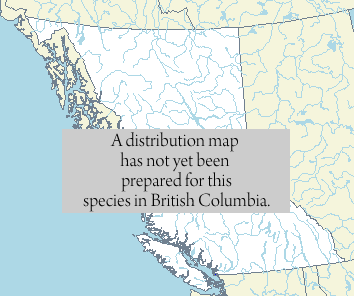In adults, the coat colour of all colour variants differs from that of any of the Mule Deer group or the White-tailed Deer. Fallow Deer are the only deer in British Columbia in which the adults have a spotted coat. The small white rump patch with its heart-shaped black border is also distinctive of Fallow Deer. The antler form with its main beam and first two forward pointing tines, followed by the palmated upper half, wider at the top than at the bottom, is unique among any deer in B.C.
For skulls, the vomer does not divide the posterior nares in Fallow Deer, and the shape of the opening on its ventral side is more pointed than it is in Odocoilid deer skulls. In the lower jaw, the first incisor is at least twice as wide as the others, and the premolars and molars, especially on lower jaw are larger than those in comparable-sized Odocoilid deer skulls. Tracks and faeces would be difficult to distinguish from native Odocoilid deer such as Columbian Black-tailed Deer.
|
Gestation is believed to be between 150 and 220 days. Usually one young is born weighing between 2 and 4 kg, and twins are rare on Sidney Island. Births in B.C. occur in late May and in June. The female gives birth in seclusion or occasionally within the herd; the young are hiders. Fallow Deer reach sexual maturity at 18 months, and females give birth for the first time either at two or three years of age. As is typical in most ungulates, most young males, though capable of breeding, are prevented from doing so by older, dominant males. Consequently, most male Fallow Deer begin mating when around five or six years old. But when overhunting removed many mature males on Sidney Island, younger males mated with females.
| On the Gulf Islands, they will occasionally eat Eel-grass washed up on the beach. Evidence of heavy browsing on the islands is shown by a distinct browse line on the trees, and Fallow Deer will even stand on their hind legs to reach higher vegetation. |
The longevity of Fallow Deer in B.C. is unknown.
|
Fallow Deer have no major predators (other than humans) on the Gulf Islands that they inhabit in B.C. Old age and starvation are the most probable natural mortality factors. When alarmed, they may make a short barking sound and hold their tail up and curled slightly over the back showing the white underside. Alarmed Fallow Deer also use a less pronounced form of the peculiar bouncing gait called stotting that is more typical of Mule Deer. Fallow Deer are hunted in Sidney Island in a private section of the Island, and there is also a carefully regulated limited entry hunt in the Sidney Spit Marine Park. At one time the population on James Island was periodically culled.
|
They are active mainly at night between dusk and dawn when they use open areas to graze, but can be seen throughout the day in the forest. For most of the year, adult males live in small groups (usually two to five members), separate from females and young (who usually form groups of five to twenty).
On Sidney Island, the rut occurs in October, and probably peaks about mid October. Although Fallow Deer mating systems in British Columbia have not been studied, elsewhere they can vary among populations, perhaps in response to deer density. In some populations, a single male guards a group of females (his harem) against other males, while in others a behaviour called lekking occurs. Lekking is rare in mammals, although not uncommon in birds. Fallow Deer is the only deer known to engage in lekking behaviour. It involves males congregating in a relatively small area called an arena, on which each adult male establishes a small territory, only a few metres in diameter. Territories are usually occupied around dawn and dusk each day when a male defends it from neighbouring males. He also displays to attract females onto his territory. When he succeeds, he tries to keep the females there long enough to court and copulate with them. Lekking is an amazing phenomenon to watch; the territorial males are almost constantly vocalizing and jerking their heads up and down. The call is a grunting snort, and the head nodding draws attention to their palmate antlers. While vocalizing, a territorial male also uses the tuft of hair on the end of the penis sheath to scatter urine over himself, probably along with glandular secretions from the preputial gland. Presumably, these odours attract females. When not trying to keep females on their small territories, males fight with neighbours, and smaller males rush in and try to steal females.
|
|
